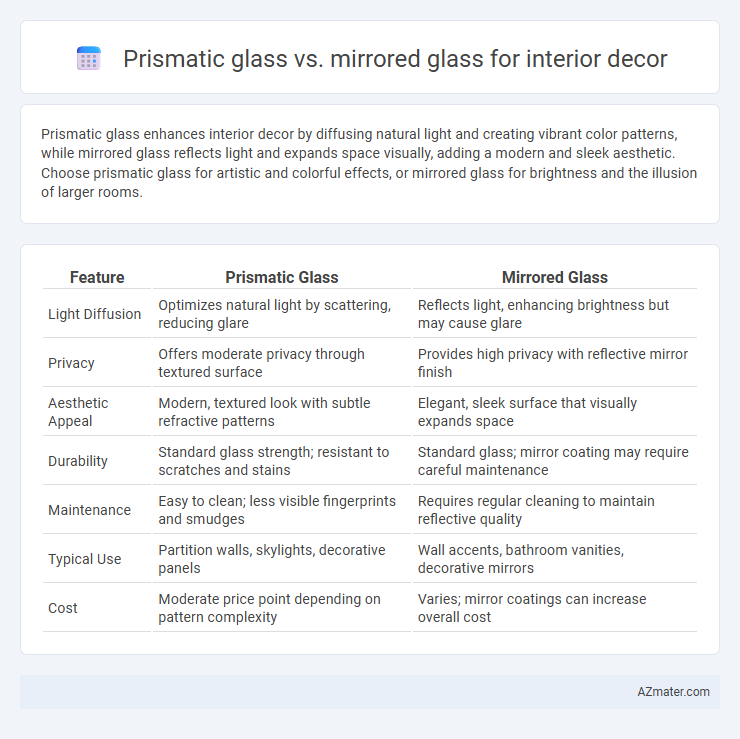Prismatic glass enhances interior decor by diffusing natural light and creating vibrant color patterns, while mirrored glass reflects light and expands space visually, adding a modern and sleek aesthetic. Choose prismatic glass for artistic and colorful effects, or mirrored glass for brightness and the illusion of larger rooms.
Table of Comparison
| Feature | Prismatic Glass | Mirrored Glass |
|---|---|---|
| Light Diffusion | Optimizes natural light by scattering, reducing glare | Reflects light, enhancing brightness but may cause glare |
| Privacy | Offers moderate privacy through textured surface | Provides high privacy with reflective mirror finish |
| Aesthetic Appeal | Modern, textured look with subtle refractive patterns | Elegant, sleek surface that visually expands space |
| Durability | Standard glass strength; resistant to scratches and stains | Standard glass; mirror coating may require careful maintenance |
| Maintenance | Easy to clean; less visible fingerprints and smudges | Requires regular cleaning to maintain reflective quality |
| Typical Use | Partition walls, skylights, decorative panels | Wall accents, bathroom vanities, decorative mirrors |
| Cost | Moderate price point depending on pattern complexity | Varies; mirror coatings can increase overall cost |
Introduction to Prismatic and Mirrored Glass
Prismatic glass features a textured surface designed to refract light and create dynamic patterns, enhancing interior decor with vibrant light dispersion and privacy. Mirrored glass offers a reflective surface that visually expands space and adds brightness by bouncing light throughout a room. Both materials serve distinct aesthetic and functional roles in interior design, with prismatic glass emphasizing light manipulation and mirrored glass focusing on reflection and spatial enhancement.
Key Differences Between Prismatic and Mirrored Glass
Prismatic glass disperses light through its textured surface, enhancing natural illumination and creating dynamic light patterns ideal for interior decor, while mirrored glass provides a reflective surface that increases visual space and adds a decorative element by reflecting surroundings. Prismatic glass excels in light diffusion and privacy, making it suitable for areas requiring natural light without direct visibility, whereas mirrored glass focuses on aesthetic appeal and spatial expansion by reflecting room elements. The choice depends on desired lighting effects and functional needs, with prismatic glass optimizing light quality and mirrored glass enhancing visual depth.
Aesthetic Impact in Interior Decor
Prismatic glass enhances interior decor by creating dynamic light patterns that add depth and texture to spaces, making rooms feel more vibrant and visually engaging. Mirrored glass provides a sleek, reflective surface that amplifies natural light and creates an illusion of expanded space, contributing to a modern and sophisticated aesthetic. Both materials serve distinct design purposes, with prismatic glass prioritizing artistic light diffusion and mirrored glass emphasizing brightness and spatial perception.
Light Reflection and Diffusion Properties
Prismatic glass enhances interior decor by dispersing light evenly across a space, creating soft, diffused illumination that reduces glare and shadows. Mirrored glass, on the other hand, provides sharp reflections and amplifies light intensity, making rooms appear larger and brighter through direct light bounce. Choosing prismatic glass improves ambiance with gentle light diffusion, while mirrored glass prioritizes brightness and visual expansion through reflective surfaces.
Energy Efficiency and Natural Light Enhancement
Prismatic glass enhances natural light distribution by refracting sunlight deeper into interior spaces, reducing the need for artificial lighting and improving energy efficiency in buildings. Mirrored glass reflects sunlight, which can minimize heat gain and glare, aiding in temperature control and reducing cooling costs. Choosing prismatic glass optimizes daylight utilization, while mirrored glass excels in controlling solar heat and glare, both contributing to sustainable interior environments.
Privacy Considerations in Glass Selection
Prismatic glass offers diffused light transmission that maintains natural brightness while obscuring direct visibility, enhancing privacy without sacrificing illumination. Mirrored glass provides a reflective surface that effectively blocks views from one side, making it ideal for spaces requiring strong privacy controls. Selecting between prismatic and mirrored glass depends on balancing desired privacy levels with light quality and interior aesthetics in your decor plan.
Suitability for Various Interior Styles
Prismatic glass enhances interior decor by diffusing light and creating dynamic patterns, ideal for modern, minimalist, and Scandinavian styles that emphasize natural light and texture. Mirrored glass offers reflective surfaces that amplify space and add a sleek, contemporary feel, making it suitable for urban, glam, and Art Deco interiors. Selecting between prismatic and mirrored glass depends on desired ambiance, with prismatic glass fostering warmth and visual interest, while mirrored glass emphasizes brightness and luxury.
Maintenance and Cleaning Requirements
Prismatic glass requires regular dusting and gentle cleaning with non-abrasive, pH-neutral solutions to maintain its light-diffusing properties, preventing surface scratches that could diminish its optical clarity. Mirrored glass demands frequent cleaning to avoid streaks, fingerprints, and spots, typically using ammonia-free glass cleaners and soft cloths to preserve its reflective finish and avoid damage from harsh chemicals. Both types benefit from immediate attention to smudges and spills to retain their aesthetic appeal and functional performance in interior decor applications.
Cost Comparison and Budget Considerations
Prismatic glass typically incurs higher costs than mirrored glass due to its complex manufacturing process and light-diffusing properties, making it a premium choice for interior decor. Mirrored glass is more budget-friendly and widely available, offering reflective qualities that enhance space without significant investment. Choosing between prismatic and mirrored glass depends on budget constraints and desired aesthetic impact, with mirrored glass preferred for cost efficiency and prismatic glass for luxury and light manipulation.
Choosing the Right Glass for Your Interior Design
Prismatic glass enhances interior decor by diffusing natural light and creating soft, colorful reflections that add depth and texture to spaces, making it ideal for ambient lighting and artistic features. Mirrored glass, on the other hand, maximizes light reflection and spatial perception, perfect for visually expanding rooms and introducing sleek, modern aesthetics. Selecting the right glass depends on desired lighting effects and spatial goals: prismatic glass for mood and visual interest, mirrored glass for brightness and room enlargement.

Infographic: Prismatic glass vs Mirrored glass for Interior decor
 azmater.com
azmater.com